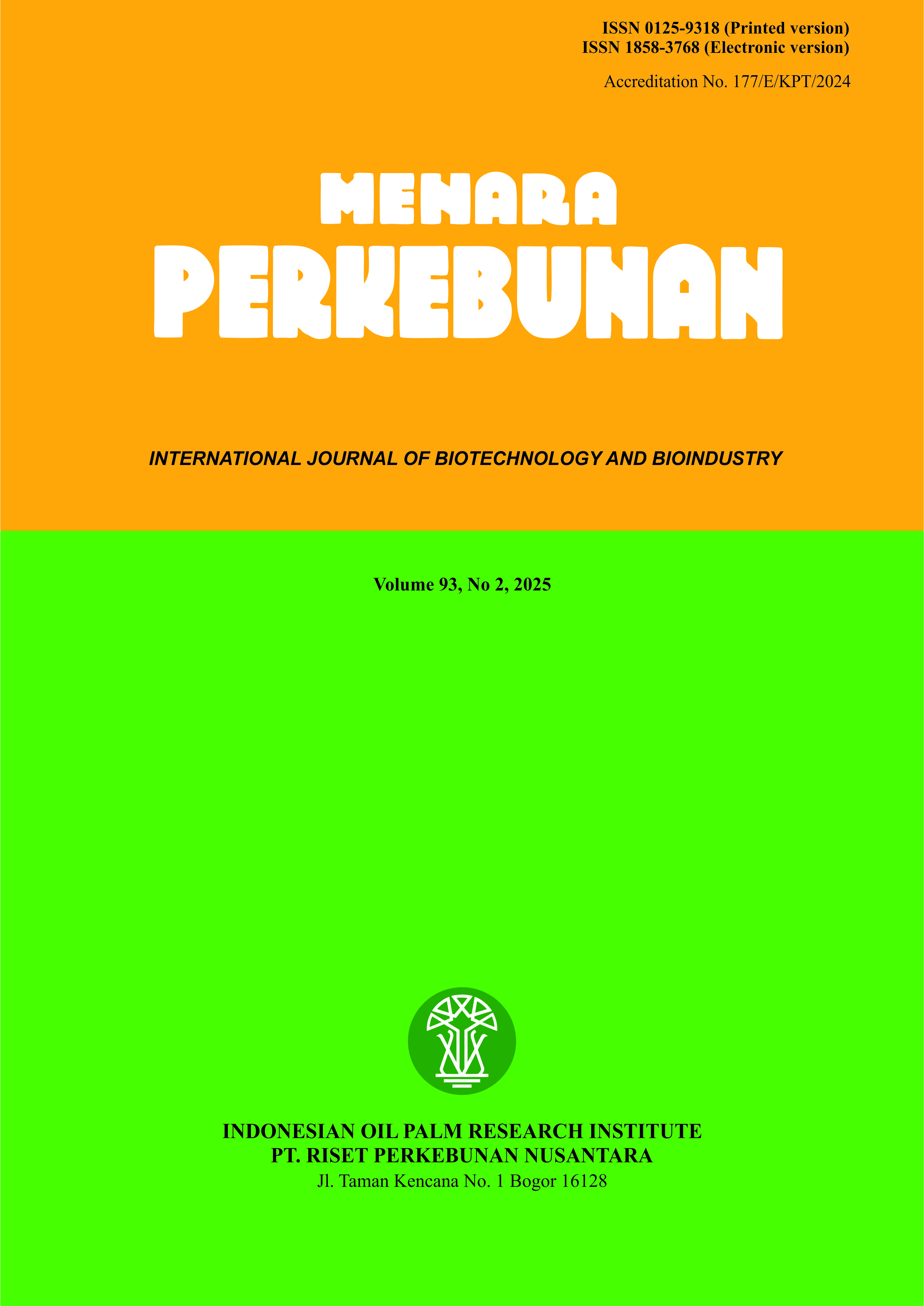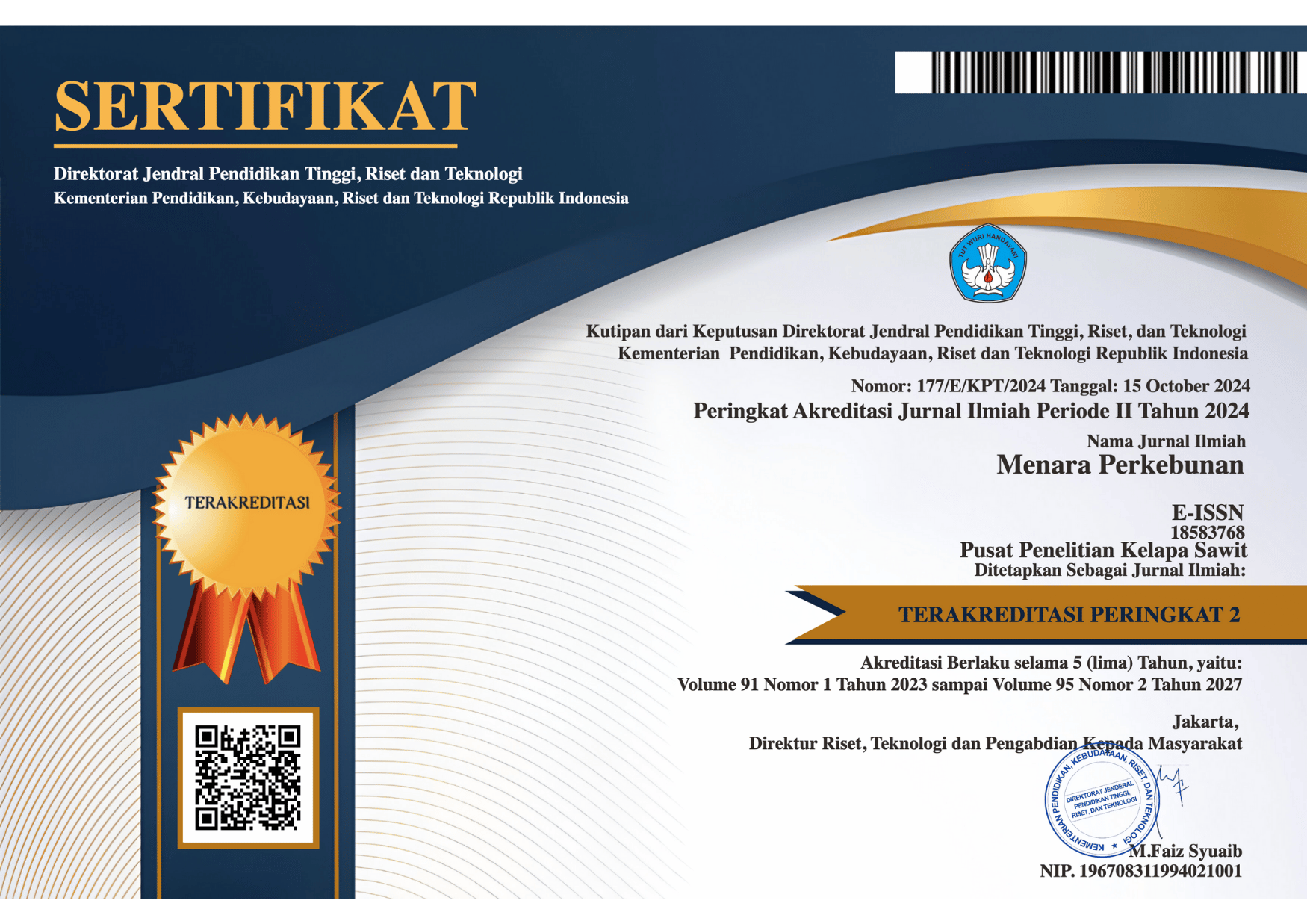Techno-economic analysis and scale-up process simulation of compost production from OPEFB using rapid decomposition system (RDS) technology with SuperPro Designer®
DOI:
https://doi.org/10.22302/iribb.jur.mp.v93i2.677Keywords:
Feasibility, organic fertilizer, palm oil biomass, rapid composting, software simulationAbstract
Oil palm empty fruit bunches (OPEFB) are biomass waste from oil palm mills (POM) that are abundant and potential as feedstock for compost. However, the conventional composting process for OPEFB is time-consuming and inefficient. A Rapid Decomposition System (RDS) technology has been developed to accelerate the decomposition of OPEFB into compost, utilising microorganisms that produce ligninolytic and cellulase enzymes. RDS combines chemical delignification (using H₂O₂) and biological processes simultaneously, which significantly reduces the composting period (generally 2–3 months to only about 45 h per batch), while also producing valuable by-products such as fulvic acid and growth stimulating hormone (GSH). The system can reduce OPEFB volume, thereby improving efficiency and sustainability. This study aims to simulate the scale-up of the RDS compost production process from OPEFB and financial feasibility. A simulation production of 5 kg of RDS compost at a larger scale (scale-up) using SuperPro Designer® software has been conducted. The results showed that 100 kg of OPEFB could produce 32.67 kg of RDS compost with a process time of 45.01 hours per batch. The financial scenario, which covers the main product (compost) and by-products (GSH and fulvic acid), yields a gross margin of 55%, a return on investment (ROI) of 68.67%, and a payback period of 1.46 years. The techno-economic feasibility analysis yielded an internal rate of return (IRR) of 41.08% and a nett present value (NPV) of $24,743,000, indicating that this technology is feasible and profitable for scaling up to industrial scale.
Downloads
References
Aulia, W. D., Permana, A. T., Dimawarnita, F., & Faramitha, Y. (2024). Delignification of empty palm oil bunches with naoh on the quality of liquid organic fertilizer. Journal of Agroindustrial Technology, 34(1), 47–54. https://doi.org/10.24961/j.tek.ind.pert.2024.34.1.47
Badan Pusat Statistik (BPS-Statistics Indonesia). (2024). Indonesian Palm Oil Production in 2023
Bentolila, M., Alshanski, I., Novoa, R., & Gilon, C. (2018). Optimization of chemical processes by the hydrodynamic simulation method (HSM). ChemEngineering, 2(2), 1–8. https://doi.org/10.3390/chemengineering2020021
Civzele, A., Mezule, L. (2024). Isolation and screening of wood-decaying fungi for lignocellulolytic enzyme production and bioremediation processes. Frontiers in Fungal Biology, 5, 1494182. https://doi.org/10.3389/ ffunb.2024.1494182
Darmawan, R. F. (2024). Kajian tekno ekonomi pemanfaatan konversi limbah biomassa refuse derived fuel (RDF) menjadi listrik melalui metode gasifikasi tiga tingkat dan mesin diesel dual fuel di Pulau Batam. [Institut Teknologi Sepuluh Nopember]. https://repository.its.ac.id /114325/
Dimawarnita, F., Maharani, K. Y., Faramitha, Y., Kalbuadi, D. N., Prakoso, H. T., Sari, I. P., Prasetyo, D., Sutanto, S., & Goenadi, D. H. (2024). Optimization of fulvic acids production from oil palm empty fruit bunches using microwave extractor. Menara Perkebunan, 92(2), 141–152. https://doi.org/10.22302/iribb. jur.mp.v92i2.582
Dimawarnita, F., Andhayu, G. S., Faramitha, Y., & Mufidah, E. (2024). Production of crude enzyme from Trichoderma sp. BIO Web of Conferences, 99. https://doi.org/10.1051/ bioconf/20249902004
Erawan, F., Utami, A. R. I., Sugiwati, S., Maryana, R., Mel, M., & Darus, L. (2023). Potential development and economic analysis of bioethanol fabrication design from oil palm biomass with ionic liquid choline acetate using SuperPro Designer (SPD) software. Journal of Physics: Conference Series, 2673(1). https://doi.org/10.1088/17426596/2673/1/012024
Gómez, J. A., Sánchez, Ó. J., & Correa, L. F. (2020). Techno-economic and environmental evaluation of cheesemaking waste valorization through process simulation using SuperPro Designer. Waste and Biomass Valorization, 11(11), 6025–6045. https://doi.org/10.1007/ s12649-019-00833-4
Harahap, A. F., Hidayat, M., & Suhanan. (2021). Utilization of oil palm empty fruit bunches as mulch in community owned oil palm plantations (case study in Simardona Village, North Sumatra). ASEAN Journal of System Engineering, 5(2). http://journal.ugm.ac.id/ index.php/ajse
Haryanti, A., Norsamsi, Sholiha, P. S. F., & Putri, N. P. (2014). Studi pemanfaatan limbah padat kelapa sawit. Konversi, 3(2), 57-66. https://doi.org/10.20527/k.v3i2.161
Howard, J. R., Amidon, T. E., Liu, S., & Wood, C. D. (2013). United States Patent (Patent US00861828OB2)
Intelligen, Inc. (2025). SuperPro Designer Overview. https://www.intelligen.com/ products/superpro-overview/
Iswahyudi, H., & Iskandar, M. D. (2023). Content of macro nutrition of fiber compost and oil palm empty fruit bunch (Elaeis guineensis Jacq.). EnviroScienteae, 19(1), 9-13. http://dx.doi.org/10.20527/es.v19i1.15731
Karimah, I., Suyuditomo, G., Harahap, A. F. P., Ramadhan, M. Y. A., Panjaitan, J. R. H., Sahlan, M., Hermansyah, H., & Gozan, M. (2021). Techno-economic analysis of furfural production with various pretreatment of oil palm empty fruit bunches using SuperPro Designer. IOP Conference Series: Earth and Environmental Science, 749(1). https://doi.org/10.1088/17551315/749/1/012042
Karunarathna, S. C., Patabendige, N. M., Kumla, J., Hapuarachchi, K. K., & Suwannarach, N. (2025). The bioactive compounds, beneficial medicinal properties, and biotechnological prospects of Fomitopsis: a comprehensive overview. Frontiers in Cellular and Infection Microbiology, 15(1534617). https://doi.org/ 10.3389/fcimb.2025.1534617
Listyarini, D., Tampubolon, G., & Widodo, F. W. (2024). Pengaruh kompos tandan kosong kelapa sawit terhadap beberapa sifat kimia tanah bekas tambang batubara dan pertumbuhan Falcataria moluccana (miq.) barneby & grimes. Fruitset Sains: Jurnal Pertanian Agroteknologi, 12(5), 309-318. https://doi.org/10.35335/fruitset.v12i5.5855
Mansyur, N. I., Pudjiwati, E. H., & Murtilaksono, A. (2021). Pupuk dan Pemupukan. Syiah Kuala University Press
Nabila, R., Hidayat, W., Haryanto, A., Hasanudin, U., Iryani, D. A., Lee, S., Kim, S., Kim, S., Chun, D., Choi, H., Im, H., Lim, J., Kim, K., Jun, D., Moon, J., & Yoo, J. (2023). Oil palm biomass in Indonesia: Thermochemical upgrading and its utilization. Renewable and Sustainable Energy Reviews, 176. https://doi.org/10.1016/j.rser.2023.113193
Nurrohmanysah, R., Indriyani, A., Ekaliana, E., & Telaumbanua, M. (2019). Microcontroller-based liquid fertilizer developer from palm empty fruit bond waste. Agroteknika, 2(2), 51–58.https://doi.org/10.32530/agroteknika.v2i2.43
Pramana, A., Hamzah, A., Haitami, A., & Okalia, D. (2021). Quality analysis of “Kosmos” OPEFB compose using selulolitic microorganism. Agrointek, 15(3), 839–844. https://doi.org/10.21107/agrointek.v15i3.10149
Roussos, A., Misailidis, N., Koulouris, A., Zimbardi, F., & Petrides, D. (2019). A feasibility study of cellulosic isobutanol production-process simulation and economic analysis. Processes, 7(10). https://doi.org /10.3390/pr7100667
Sakiah, S., Arfianti, D., Silalahi, A. B., & Lesmana, I. (2024). Pemanfaatan Trichoderma sp dan Aspergillus sp. dalam pengomposan tandan kosong kelapa sawit. Tabela Jurnal Pertanian Berkelanjutan, 2(1), 37-43. https://doi.org/ 10.56211/tabela.v2i1.459
Sentana, S., Suyanto, Subroto, M. A., Suprapedi & Sudiyana, (2010). Pengembangan dan pengujian inokulum untuk pengomposan limbah tandan kosong kelapa sawit. Jurnal Rekayasa Proses, 4(2), 35
Utami, A. R. I., Sugiwati, S., Maryana, R., Darus, L., Mel, M., Maulidin, I., Erawan, F., Yupaldi, N., & Zhafran, A. L. (2025). Predictive modelling of ethanol production from biomass pretreated with ionic liquids using SuperPro Designer. Journal of Physics: Conference Series, 2942(1). https://doi.org/10.1088/ 17426596/2942/1/012048
Zaman, N. Z. I. S., Abbas, A. R., Zainal, M. F., Quek, A., Ata, W. N. S. W., Mohd Yapandi, M. F. K., & Ibrahim, Z. F. (2024). Assessing the environmental impact of empty fruit bunches for electricity generation in Malaysia: A life cycle perspective. IOP Conference Series: Earth and Environmental Science, 1372(1). https://doi.org/10.1088/17551315/1372/1/012057
Downloads
Submitted
Accepted
Published
How to Cite
Issue
Section
License
Copyright (c) 2025 Silva Latisya, Firda Dimawarnita, Yora Faramitha, Mujahidah Kamilah, Serarifi Elagin Harahap, Didiek Hadjar Goenadi

This work is licensed under a Creative Commons Attribution 4.0 International License.
Authors retain copyright and grant the journal right of first publication with the work simultaneously licensed under a Creative Commons Attribution License that allows others to share the work with an acknowledgement of the work's authorship and initial publication in this journal.













